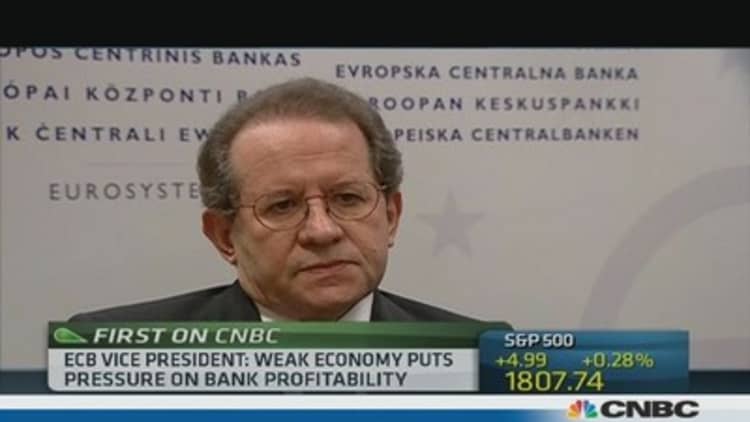The European Central Bank on Wednesday issued a stark warning over the threat posed by the scaling back of U.S. monetary stimulus, calling on euro zone policy makers to do more to prepare for the market shocks from Federal Reserve "tapering".
In its latest financial stability report, the ECB said the risks to the euro zone's financial system from outside the currency bloc had grown since May due to the Fed's talk of scaling back its $85 billion of monthly bond purchases – despite a general improvement in market conditions.
(Read more: Cashin: Taper not priced into market)
"Starting in May, there was a significant repricing in global bond markets, which took place largely because of changing monetary policy expectations in the United States – with increased foreign exchange market volatility and stress borne largely by emerging market economies," the ECB said.
The Fed could taper as early as December if crucial jobs numbers due next week show enough momentum in the U.S. labor market. Economic data released on Wednesday were mixed: a strong Chicago manufacturing index – which came in at 63, above consensus forecasts of 60 – was offset by a fall in durable goods orders.

After sending shock waves through global financial markets this summer, the Fed came under international pressure to communicate more clearly, but its mandate to focus on employment and inflation in the U.S. means it does not consider the ripple effect of its decisions overseas.
The ECB said the euro zone's institutional investors were more exposed to bond markets than the region's banks, but that it was difficult to know where the risks of ultimate losses were greatest.
"It cannot be ruled out that ultimate exposures are concentrated among a limited number of entities which may now be more vulnerable to any further severe market shock," the ECB said.
(Read more: Euro zone financial stress down to near pre-crisis levels: ECB)
It added that the recent turbulence meant that policy makers needed to ensure banks, insurers and pension funds could cope with a "normalization" of yields from their current historically low levels.
"Stable and predictable" macroeconomic policies by member states, as well as measures such as the ECB's forward guidance to markets and the public on interest rates, would help smooth the exit from central banks' exceptional monetary easing without an abrupt rise in global bond yields, the central bank said.
In the latest edition of its twice-yearly report, the ECB said risks of turbulence from within the euro area had receded since its previous report was published in May, despite the turbulence caused by the Fed chair Ben Bernanke's comments that the US central bank would begin to cut back on its bond buying once the world's largest economy neared a full recovery.
More from the Financial Times:
Fed's Bernanke on a mission to explain
Fed eyes options to offset end of QE3
Euro drops on ECB's interest rate cut move
The ECB said weak bank profitability and persistent financial fragmentation still presented a threat to stability. Banking union would be "an important contribution" to resolving these hurdles.
The ECB said the improvement in overall conditions in part reflected better economic fundamentals on the back of fiscal and structural reforms. But a lack of reform in the months ahead threatened to derail these improvements, raising tensions in sovereign debt markets.
Unforeseen bank recapitalization also posed a threat. "Although provisioning is increasing, it has barely kept pace with the deterioration in asset quality, on average, highlighting a potential further need for additional reserves to strengthen bank balance sheet resilience in case asset quality deteriorates further."
(Read more: The Fed has created a huge global bubble: Stockman)
The ECB cut its main refinancing rate earlier this month to a record low in a fresh bid to bolster the currency bloc's shaky economic recovery and said there were still further tools it could use.
Speaking in a press conference on Wednesday, Vítor Constâncio, the ECB's vice-president, appeared to downplay the likely use of one of those tools: cuts that would push the ECB's deposit rate into negative territory.
Such a move could only be considered in "extreme situations" he said, while reiterating that the ECB was technically prepared to cut the rate, which is now at zero. Mr Constâncio noted that negative rates had been used in Denmark, but he said it was a different matter introducing them in a large economy such as the euro area.
Discussing the finances of the euro area banks, Mr Constâncio said that profits had been driven sharply down by the cost of provisioning for non-performing loans. This situation had been "aggravated" by banks boosting their provisions as they prepared for the forthcoming comprehensive assessment of the banking system that will be conducted by the ECB, he said.
(Read more: Like the Fed, ECB expected to keep on pumping)
This was likely to be a temporary situation, he argued, predicting that the comprehensive assessment would dispel remaining doubts about the robustness of euro area banks.
The exercise is essential to rebuilding trust in the banks and reducing the fragmentation of the region's financial system, he added. The ECB would do the exercise in a "very vigorous and credible way" he said, acknowledging that the reputation of the planned Single Supervisory Mechanism was at stake.

